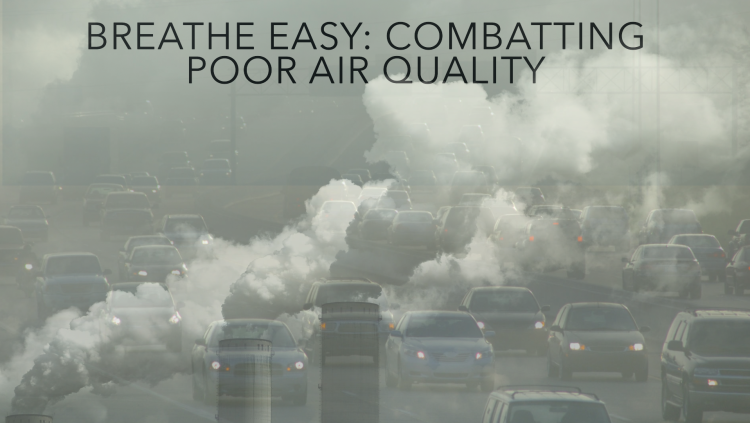Breathing Danger: How Poor Air Quality Impacts Your Health and What You Can Do About It
Imagine this: it’s a hazy morning in Delhi. You step outside, take a deep breath, and immediately feel the sting in your throat. Sounds familiar? If you’ve ever felt uneasy and weird about the air you’re breathing in , you’re not alone. Air pollution is not just an environmental problem; it’s a health crisis affecting many in India.
Let’s explore the impact of poor air quality on your health, and more importantly, what you can do to protect yourself and your family.
How Does Air Pollution Harm Your Body?
Ever wondered why your throat feels scratchy or your head aches on days when the air quality is bad? The pollutants in the air, like PM2.5, nitrogen oxides, and carbon monoxide, don’t just vanish after entering your lungs. They go deeper, impacting multiple systems in your body.
1. Your Lungs Take the First Hit
•Feel This: Take a deep breath and imagine holding it for a moment. Now, think about fine particles (PM2.5) invading your lungs, causing irritation, inflammation, and even permanent damage.
•What Happens: Chronic exposure can lead to asthma, bronchitis, and even lung cancer over time.
2. Your Heart Feels the Pressure
•Pollutants enter your bloodstream and cause inflammation. This can lead to high blood pressure, heart attacks, and strokes.
•Air pollution is as bad for your heart as smoking cigarettes!
3. Your Brain Isn’t Safe Either
•Think About This: You’ve had a long, polluted commute, and now you can’t focus at work. That’s because pollutants can affect your cognitive function. Studies even link pollution to conditions like Alzheimer’s and anxiety disorders.
4. The Hidden Impact on Kids and Pregnant Women
•Children exposed to polluted air may have stunted lung development and weakened immunity.
•Pregnant women breathing toxic air risk preterm deliveries and low-birth-weight babies.
Why is India’s Air Quality So Bad?
Let’s understand the surge behind increased air pollution.
•Vehicles Everywhere: Over 300 million vehicles clog India’s roads, emitting harmful gasses.
•Factories and Power Plants: Coal-based industries are a major source of pollutants.
•Crop Burning: Every winter, stubble burning in Punjab and Haryana creates a toxic smog blanket over northern India.
•Household Pollution: In rural areas, solid fuels like wood and dung are still used for cooking.
What Can YOU Do to Stay Safe?
While you can’t control the entire city’s air, you can take steps to protect yourself.
1. Know When to Stay Indoors
•Check AQI daily. On hazardous days (AQI over 300), avoid outdoor activities, especially early mornings when pollution is worse.
2. Use Air Purifiers at Home
•Invest in a good air purifier, especially if you live in cities like Delhi or Kolkata. Pro tip: Look for one with a HEPA filter.
3. Mask Up!
•Use N95 masks when stepping outside during poor air quality days.
•Think of it as sunscreen for your lungs—it’s a must!
4. Green Your Space
•Add air-purifying plants like snake plants or areca palms to your home. They’re natural filters! India needs big, bold moves to tackle air pollution. But solutions begin with awareness and action.
For Governments
•Enforce stricter vehicle emission norms like BS-VI standards.
•Expand public transport options to reduce dependency on private cars.
•Incentivize farmers to adopt alternatives to crop burning, like Happy Seeders.
For Businesses
•Invest in cleaner, renewable energy sources.
•Transition to electric vehicle fleets for logistics.
For Individuals Like Us
•Opt for public transport, carpooling, or cycling whenever possible.
•Reduce energy consumption, turn off those lights and fans when not needed!
•Spread awareness and help people learn about the problems.
Can Technology Save Us?
Yes, and here’s how:
•Air Monitoring Apps: Use tools like SAFAR for real-time AQI updates.
•Electric Vehicles (EVs): Switching to EVs is a win for both your wallet (long-term) and the planet.
•AI Solutions: Artificial intelligence can predict pollution hotspots and optimize traffic to reduce emissions.
In conclusion, poor air quality is more than an environmental issue, it’s a serious health threat. While the problem is vast, small actions like monitoring air quality, using purifiers, and adopting greener habits can make a difference. Governments, businesses, and individuals must work together to create lasting change. Every step counts, because clean air is essential for a healthier, brighter future.

